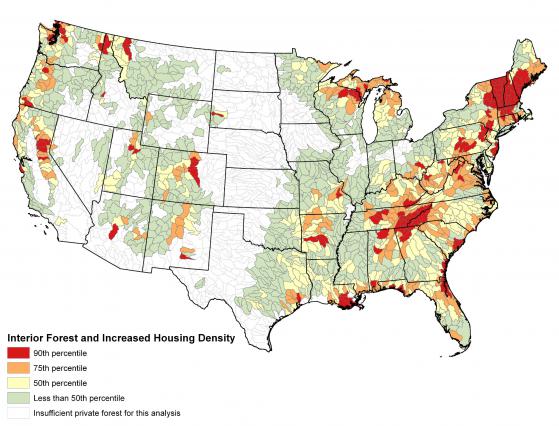The Pioneer Valley, and the area around Brattleboro and Keene, are at the highest risk nationally of having privately owned forests turned into parking lots, roads, strip malls, vacation houses, and other kinds of so-called "development." That's according to the U.S. Forest Service's map, below. Susan Stein wrote the 2009 report that the map appeared in. She works for the Forest Service. “Based on today's data, the map would probably be similar,” Stein told the Valley Post earlier this month.
The map refers to “interior forest.” Stein said in an e-mail, “In the map, to qualify as 'interior,' each 30 by 30 meter pixel had to be forested, as did 90 percent of each surrounding pixel. The idea was to identify those areas that are predominantly uninterrupted forest (i.e., not broken by an area of non-forest).”
Forests reduce global warming. If forests aren't saved, and if other steps aren't taken to reduce global warming, the world's leading scientists say millions of people could be killed by famine and floods.
According to www.wilderness.org, "Wilderness is a vital habitat for wildlife.... Without designated wilderness, it would be virtually impossible to ensure the protection of species. Wilderness is a haven from the pressures of our fast-paced society. It provides us with places where we can seek relief from the noise, haste and crowds that too often confine us. It is a place for us to enjoy with friends and families — strengthening our relationships and building lasting memories."
Forest near Keene last summer. photo by Eesha Williams
----------
In local land-use news, Amherst's annual town meeting starts on April 28 at 7 p.m. at the Amherst Middle School. www.KestrelTrust.org is asking Amherst residents to attend the meeting and vote “yes” for funding to create the Fort River Farm Conservation Area and protect 20 acres of prime farmland and wildlife habitat.
“The project, known as Fort River Farm Conservation Area in Amherst, would protect nearly 20 acres of prime farmland and wildlife habitat along this important tributary of the Connecticut River,” according to the Trust's site. “The Fort River is home to the federally endangered dwarf-wedge mussel, among other aquatic species. In addition to conserving the land, the Town plans to create a unique integration of public community gardens, passive recreation, and agricultural education for children, adults, and new farmers, close to the village center. The land abuts other permanently protected farmland. Kestrel would hold a permanent Conservation Restriction on the town-owned land to ensure its protection in perpetuity.”
The town of Belchertown, Massachusetts, near Amherst, has its annual town meeting on May 12. Kestrel Trust is asking townspeople to attend the meeting and vote “yes” for funding to add 90 acres of unbroken forest lands to the Jabish Brook Conservation Area. “This rolling forest terrain with mature oak and other tree species lies near the Quabbin Reservoir,” the Trust site says. “Protecting this large tract of contiguous forestland would support wildlife habitat and provide a critical corridor from the Mount Holyoke Range to the 38 square miles of protected lands surrounding the Quabbin. Large mammals like black bear, moose and bobcat rely on this area. Conserving the land would also protect a critical watershed for three towns and one city. Jabish Brook runs through the property and directly into the Ludlow Reservoir.”
Hatfield, Massachusetts, near Northampton, will hold its annual town meeting on May 13. Kestrel Trust is asking people to go to the meeting and vote “yes” to expand the Terry Blunt Conservation Area by conserving 32 acres along Chestnut Mountain Road.
According to www.KestrelTrust.org, in South Hadley, Massachusetts, near Holyoke, “a landowner recently donated a conservation restriction to the town on 48 acres to protect woodlands, streams, vernal pools, and high priority wildlife habitat in the Stony Brook watershed.”
Another landowner recently donated 15 acres to the town of Belchertown, “to create the new Boncik Woods Conservation Area, a beautiful wooded property with a mix of upland and valuable wetlands,” the Kestrel Trust site says.
In March, with Kestrel’s assistance, the state added 44 acres to the Mount Holyoke Range State Park, which is in Amherst and other towns.
In the Brattleboro area www.vlt.org is saving forests. In the Keene area www.MonadnockConservancy.org is doing the same.
Direct action to save forests has had some remarkable successes across the country. In the 1990s, thousands of people attended rallies in favor of saving the ancient Headwaters redwood forest in northern California from logging plans by Maxxam Corporation. Hundreds of people were arrested for non-violent, civil disobedience. In 1996, the federal government bought 7,500 acres to create the Headwaters Forest Preserve. Logging is forbidden in the reserve.
To enlarge the map, click on it, then scroll down and click "see full size image." To find this map online, go to
www.fs.fed.us/openspace/fote/benefits_download.html
click on "part two," then see figure 13 on page 30.
-------------


Post new comment